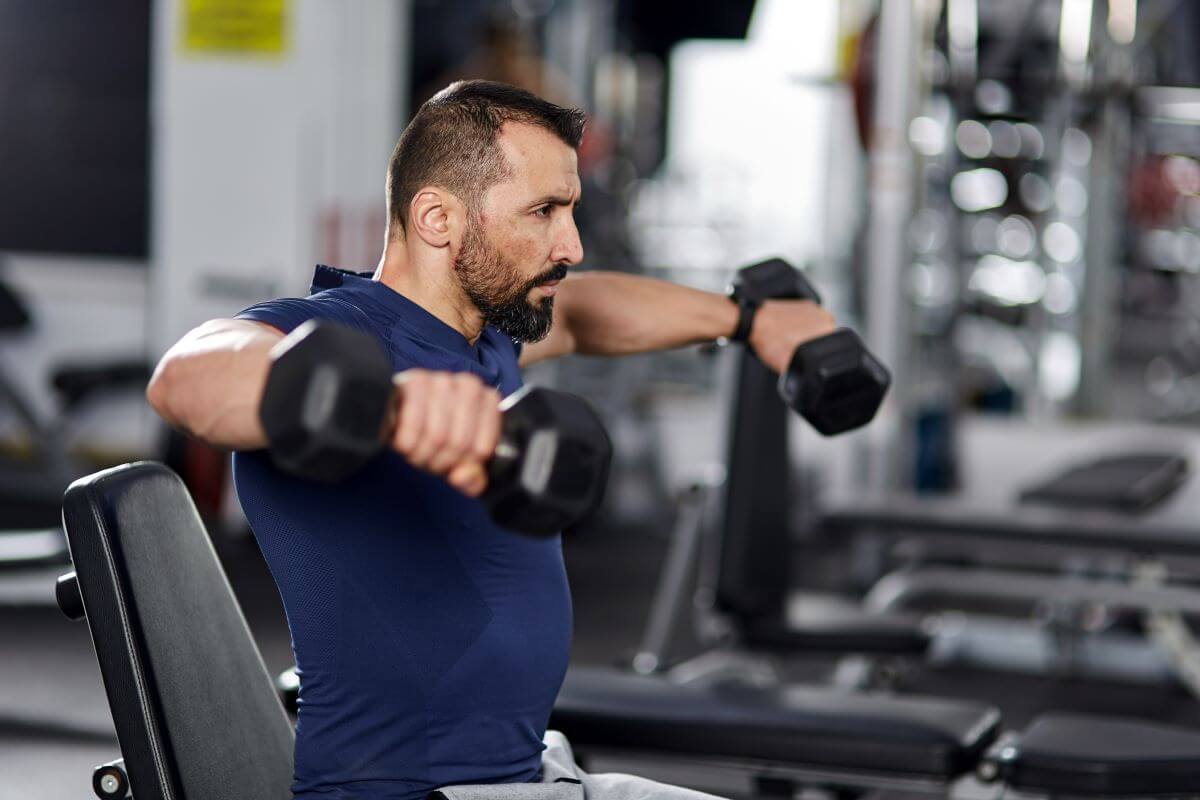If you’ve ever watched a bodybuilding workout on YouTube, you’ve likely seen someone performing seated dumbbell lateral raises during their shoulder day.
The seated dumbbell lateral raise is a shoulder exercise and a variation of the traditional dumbbell lateral raise which is performed while standing.
And for a number of reasons, bodybuilders enjoy adding this variation to their workouts over other lateral raise exercises.
The primary reason is that since the exercise is performed while seated, it is very difficult to cheat the rep using momentum to carry the weight to shoulder level. It also makes it easier to focus on isolating the deltoids to perform the exercise compared to the standing variation that can involve the trap muscles to a greater degree.
So, now that you’ve been introduced to the exercise, let’s describe how to perform it, what muscles it works, how to add it to your workouts, and some of the variations that you can further research to find the right exercise for you.
How to Perform the Seated Dumbbell Lateral Raise
As mentioned, the dumbbell lateral raise can be performed either standing or seated. In this article, we will focus on the seated variation.
- Select the weight you wish to perform the exercise with. Generally, this exercise is performed using lighter weights and higher rep schemes.
- Grab a bench and adjust it to the seated position.
- Sit on the bench with your back firmly against the back pad and a dumbbell in each hand at your side.
- Engage your core and lower body by pressing through the ground with your feet.
- Raise your arms while maintaining a slight bend in your elbow until your arms reach shoulder height and your arms are parallel to the floor.
- Reverse the movement and slowly lower the weight to the starting position maintaining control and tension throughout.
- Repeat for the desired number of repetitions.
What Muscles Does the Seated Dumbbell Lateral Raise Target?
The primary muscle group worked during the seated dumbbell lateral raise is the shoulders. This includes all three heads of the deltoid: Middle, posterior and anterior. The exercise will primarily target the middle deltoid throughout the range of motion.
Additionally, to a lesser extent, your forearms will be targeted by gripping the weight and carrying it through the range of motion in your hands.
How to Add Dumbbell Seated Lateral Raises to Your Workouts
The dumbbell lateral raise from a seated position will likely be the third or fourth exercise you perform during a workout. It is generally seen as a pure isolation exercise and will often be performed as a finisher in most workout programs.
Some bodybuilders may utilize it before their main movement as a way to pre-fatigue the muscle, however, for most people it will be beneficial to treat it as a pure accessory movement towards the end of your workout. It may also be a good exercise to select for a shoulder superset.
The seated dumbbell lateral raise can be seen in any style of workout including full body workouts, upper/lower workouts, push/pull/leg workouts, and bro split style workouts.
The exercise will be performed on upper workout days during upper/lower workout splits.
Although some categorize the exercise as a pull exercise, it is generally included in push workouts when used in push/pull/leg splits. This makes since given the fact that you are targeting a push muscle in the shoulders.
People who use bro splits will include the dumbbell seated lateral raise in their shoulder workout days.
The general set and rep scheme for the exercise is 2-3 sets of 10-25 repetitions. Rest periods will also be kept shorter and will fall in the 30-60 second range.
Lateral raises in general can be performed 2-4 times per week (or more depending on your goals and experience level). However, it may be beneficial to alternate between seated and standing if performing more than twice per week.
Seated Dumbbell Lateral Raise Variations
Listed below are a few variations of the dumbbell seated lateral raise that you can further explore. As I write more exercise guides, I will link the appropriate article to the exercise. In the meantime, feel free to search YouTube for demonstrations of the exercise.
- Standing Dumbbell Lateral Raise
- Bent Over Seated Dumbbell Lateral Raise
- Seated Machine Lateral Raise
Conclusion
The seated dumbbell lateral raise is a solid choice for anyone looking for an exercise that completely isolated the shoulder with an emphasis on the middle deltoid.
It will generally be performed as one of the final movements of your workout and with a higher rep scheme than the compound exercises you use to build strength.
If you have any questions about the seated dumbbell lateral raise or anything mentioned in this exercise guide, please feel free to leave a comment below!
